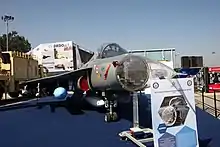Uttam AESA Radar
Uttam is a solid-state gallium arsenide (GaAs) based active electronically scanned array (AESA) radar under development by the Electronics and Radar Development Establishment (LRDE), a laboratory of the Indian Defence Research and Development Organisation (DRDO). It is a low probability of intercept radar intended to be installed on the HAL Tejas Mark 1A, HAL Tejas Mark 2 and HAL TEDBF aircraft with plans to implement a larger and more powerful variant on-board India's 5th Generation fighter aircraft, HAL AMCA.[1][2][3]
 | |
| Country of origin | India |
|---|---|
| Manufacturer | Bharat Electronics Hindustan Aeronautics Limited |
| Designer | Electronics and Radar Development Establishment |
| Introduced | In development |
| Type | Solid-state AESA |
Description
It is a liquid cooled AESA radar featuring quad band modules that can be stacked to form a larger unit. This allows the manufacturer to scale the radar to be used in larger aircraft. There are plan to create a larger scalable design to be used in India's fifth-generation HAL AMCA jet fighter.[4]
The radar development began in 2012 and its full-scale model was displayed at the 2017 Aero India air show and aviation exhibition.[5] A fully functional AESA radar prototype was unveiled at Aero India 2019, the prototype was mounted inside the glass nose of a HAL Tejas prototype.[6] As of 2021, three units were in various phases of testing,. The Uttam radar has completed 230 hours of airborne testing onboard two Tejas fighter jets (LSP2 and LSP3) and on an executive jet; presumed to be DRDO's Dornier 228 "Nabhratna" used as a flying test bed by LRDE.[7] Once fully validated and certified, it is planned is to introduce the radar in later batches of Tejas Mark 1A aircraft.[2][8] The Uttam radar will be used with DRDO's Unified Electronic Warfare suite.[9]
During Aero India 2021, there was a licensing agreements for technology transfer from DRDO to Hindustan Aeronautics Limited for manufacturing and integration of the Uttam in the Mark 1A variant of the HAL Tejas.[10]
Indian Air Force Test Pilot School will start final demonstration trial of Uttam AESA radar from December 2021 and if successful will be sent for serial production. As per Project director D Seshagiri of Electronics and Radar Development Establishment (LRDE), Uttam AESA radar is 95% indigenous, with only one imported subsystem. The radar has the capacity to track 50 targets at a range greater than 100 km while engaging 4 targets simultaneously. All 83 Tejas Mark 1A and AMCA will come equipped with this radar. Uttam AESA radar will also be installed into upgraded Sukhoi Su-30MKI and Mikoyan MiG-29K currently in use as front line platform of Indian Air Force and Indian Navy. Hindustan Aeronautics Limited is the lead integrator and Bharat Electronics is major supplier of subsystems. LRDE already completed 250 hours of performance testing on two Tejas fighters as well as Hawker 800 executive jet. National Flight Testing Centre had evaluated the radar and cleared it after performance tests. The integration problem of Astra BVRAAM due to older generation of radars will also be solved by Uttam.[11]
During the Upgrades on Su-30MKI as a part of the "Super Sukhoi" upgrade , it was revealed that an advanced version of the uttam radar , called the Virupaaksha radar will be used in place of the present PESA Bars radar under a package worth over Rs 65,000 crore where 84 planes would be upgraded indigenously with advanced made in India radars and weapon systems.[12]The Indian Air Force has already decided to replace the Israeli radar on the LCA Tejas Mark 1A fighter jet with the indigenous Uttam Active Electronically Scanned Array radar along with the Angad electronic warfare suite.
Features
- Full solid-state (electronics) radar, based on GaAs
- High MTBCF (redundancy)
- Extended detection ranges
- Multi Target Tracking (50 Targets), Priority Tracking (4 Targets).[11]
- Simultaneous operation modes.
- Solid-state, active phased array technology
- Pulse Doppler, all aspect, shoot down capabilities
- Simultaneous multi-target tracking and engaging
- Simultaneous multi-mode operation
- High ECM immunity
- Ultra-low side-lobe antenna
- Flexible interfaces allowing scalable design.
- Modular hardware and software
- Fast-beam agile system
- Quad band TRM modules pack
- High mission reliability (built with redundancy)
- IFF modes.
- C-band LOS, Ku band satcom link.
Operational Modes
Uttam AESA radar has a total of 18 modes in Air to Air, Air to Ground and Air to Sea roles. The modes have been validated on-board a business jet and further proofing is being done on HAL Tejas to validate the same on supersonic platform.[13]
- Air-to-Air
- TWS/Multi-target detection and tracking
- Multi-target ACM
- High resolution raid assessment
- Air-to-Ground
- High resolution imaging (SAR Mode)
- High resolution tracking (SAR Mode)
- AGR – Air-to-Ground Ranging
- RBM – Real Beam Map
- DBS – Doppler Beam Sharpening
- GMTI on RBM, SAR
- Weather
- Air-to-Sea
Gallery

 Uttam AESA radar on display at Aero India 2019
Uttam AESA radar on display at Aero India 2019 Side profile of Uttam AESAR.
Side profile of Uttam AESAR. The Active Antenna Array Unit (AAAU) of Uttam AESA radar on static display at Aero India, 2019
The Active Antenna Array Unit (AAAU) of Uttam AESA radar on static display at Aero India, 2019
See also
References
- Roblin, Sebastien (12 August 2017). "Is India on the Verge of Building a Super Jet Fighter?". The National Interest.
- Ajai Shukla. "Rs 26k-crore order for building Tejas Mark 1A to open door for Mark 2". Business Standard. Retrieved 16 December 2019.
- "Atma Nirbhar defence: Indigenous projects to look out for at Aero India 2021". The Week. Retrieved 8 February 2021.
- "Uttam AESA radar: Everything you need to know". Aero Journal India. Retrieved 14 January 2019.
- "Uttam AESA radar ready for induction in Tejas MK1A".
- "India Displays Locally-made AESA Radar for Tejas Jet at Aero India 2019". DefenseWorld. Retrieved 20 February 2019.
- "Exclusive: Why desi Uttam AESA radar is a game-changer".
- "HAL cuts its profit on Tejas Mark 1A deal by 50%, fighter jets to take to sky by 2022". The Print. Retrieved 19 March 2020.
- "Single Engine Fighter Cancellation Provides An Opening For Tejas MK-2". Delhi Defence Review. Retrieved 26 February 2018.
- "DRDO hands over Licensing Agreements for Transfer of Technology for 14 technologies to 20 industries". PIB. 5 February 2021.
- Gupta, Shishir (8 December 2021). "India develops AESA radar to make IAF fighters more lethal". Hindustan Times. Retrieved 8 December 2021.
- "India plans to equip Russian-origin Su-30MKIs with indigenous 'Virupaaksha' radar - The Economic Times". m.economictimes.com. Retrieved 26 October 2023.
- Uttam AESA Radar Update with Project Director Mr. D Seshagiri (LRDE). Delh Defence Review. Retrieved 7 February 2020.